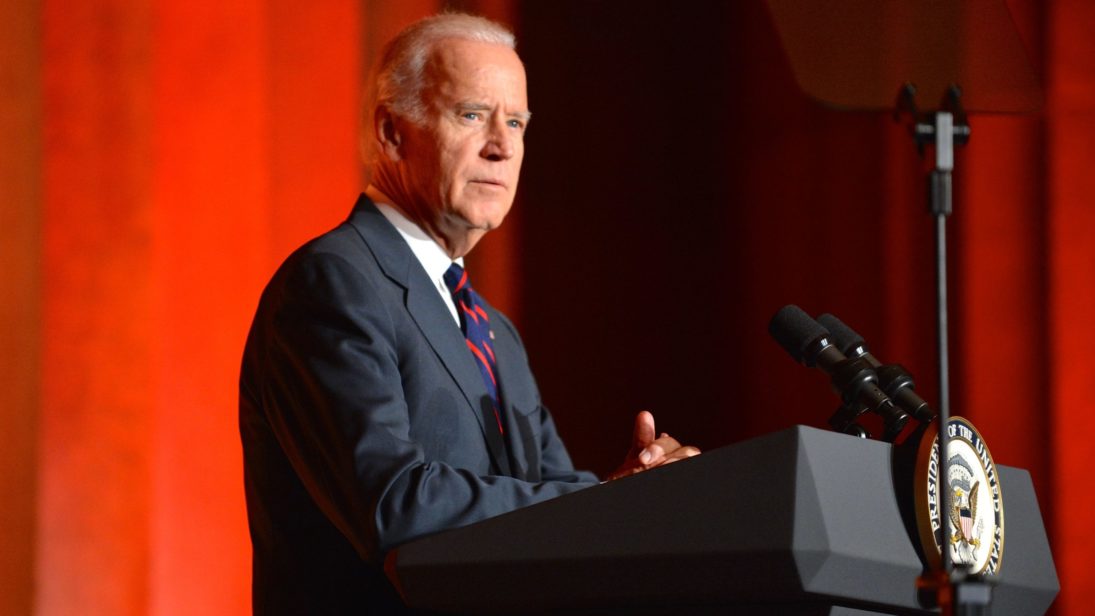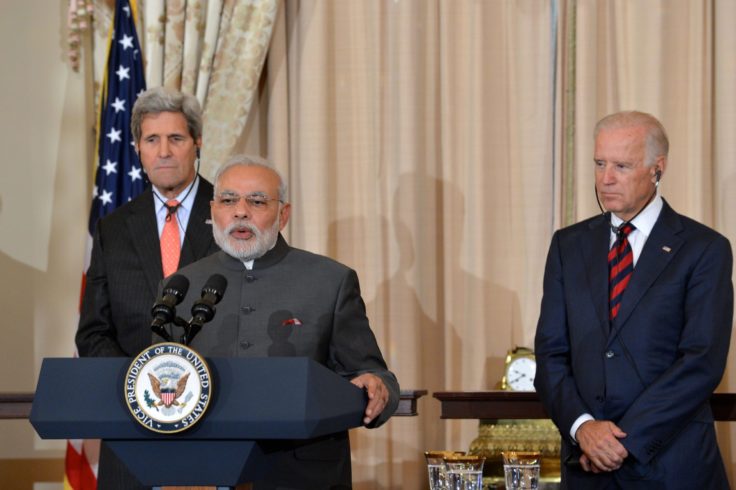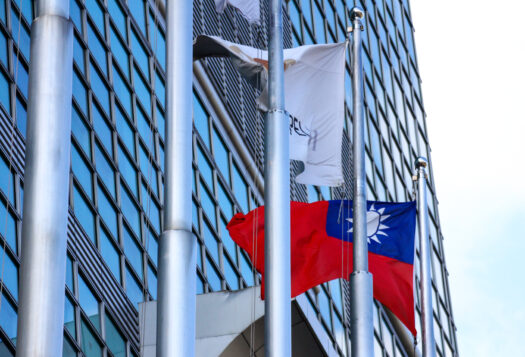
“The question is no longer whether it is in the interest of the United States or India to build a strong relationship […] into the defining partnership of the century ahead. The question is how ambitious and how rapidly are we prepared to build that partnership. And I believe […] we should be bold.” Though Joe Biden made these remarks as vice president during a lunch he hosted for Prime Minister Narendra Modi in September 2014, they encapsulate his vision for the Indo-U.S. relationship in 2021 and beyond as president of the United States.
Biden has significant familiarity with India, not only through his time as U.S. vice president but also as chair of the U.S. Senate Foreign Relations Committee. He’s aware of both the potential of and hurdles in growing the United States-India trade and economic relationship, has advocated for enhancing the bilateral strategic partnership and pursuing greater regional coordination, and sought a broader relationship than one just based on security and economics to include people-to-people ties and scientific collaboration, such as on climate change. These themes are also visible in the priorities Biden and Vice President-elect Kamala Harris have identified for the Washington-New Delhi relationship going forward.
But overall, the most critical element of the Biden administration’s policies toward India will be continuity with the past. The goal of every U.S. administration since President George W. Bush has been supporting India’s rise as a global power and enhancing its role as a net security provider in the Indian Ocean region by building India’s material capabilities through arms sales and co-development of weapon systems; enhancing military interoperability with India through exercises and foundational agreements; bringing India to the global high table by supporting its membership in multilateral institutions; and consulting with New Delhi on regional issues of mutual interest.
This is borne out by how similar the policies of the Obama-Biden and Trump-Pence administrations regarding India were, despite their stark ideological differences. The Obama-Biden administration sold India advanced arms and equipment such as surveillance aircraft and attack helicopters, and designated it as a “Major Defense Partner,” supported India’s bid for a permanent seat at the United Nations Security Council, and worked to secure its inclusion into the Nuclear Suppliers Group (albeit unsuccessfully), Missile Technology Control Regime, and the Wassenaar Agreement. The Obama-Biden government also issued a Joint Strategic Vision for the Asia-Pacific and the Indian Ocean Region with India, the first official promulgation of the two countries’ shared interests in the Indo-Pacific region. Further, they initiated the Defense Technology and Trade Initiative (DTTI), a mechanism to ease bureaucratic hurdles in co-production and co-development of defense equipment, and also signed the Logistics Exchange Memorandum of Agreement, which would allow the United States and India to access each other’s military facilities for refueling, repair and maintenance, and a general replenishment of supplies.
Biden will inherit a deepened and further institutionalized United States-India relationship from Trump, which he is likely to take forward and continue building in a fashion similar to his predecessors.
All of this was maintained or expanded under the Trump administration, whether in terms of arms sales, diplomatic support for India, cooperation in the Indo-Pacific and building interoperability through the signing of the two remaining foundational agreements in 2018 and 2020, or repurposing the Obama-Biden era Strategic and Commercial Dialogue into the 2+2 ministerial dialogue.
Biden will inherit a deepened and further institutionalized United States-India relationship from Trump, which he is likely to take forward and continue building in a fashion similar to his predecessors. Indeed, he has pledged to improve two-way trade, enhance counterterrorism cooperation, and bolster the Indo-U.S. strategic and global partnership to secure common values and interests. Antony Blinken, foreign policy adviser to the Biden-Harris campaign, has asserted that “there’s probably no common global challenge we can solve without India,” signifying the importance the Biden-Harris administration places on the relationship.

Perhaps the biggest of those challenges is China, which continues to drive the two countries closer together. The narrative on China in Washington has changed since the Obama-Biden administration, with both Democrats and Republicans now asserting that the decades-old U.S. policy of seeking to shape and moderate China’s behavior by diplomatic engagement and encouraging its economic liberalization is not working and needs to be overhauled. This thinking pushed the Trump administration to label China a “strategic competitor” in its 2018 National Defense Strategy, and formulate an Indo-Pacific strategy to push back against the Chinese challenge to the U.S.-led rules based order with support from like-minded countries such as Australia, India, and Japan. This U.S. approach to China is likely to continue in substance if not in tone under Biden, as indicated by his likely pick for secretary of defense, Michèle Flournoy. Further, Biden’s stance that combining forces with democracies doubles the United States’ strength in tackling the China challenge and his proposal to host a summit of democracies suggests he would further empower the Quad. And while India may not see as much bombastic U.S. rhetoric and overt shows of support against Beijing as it did in the Trump administration, Biden would continue bolstering Indian capabilities, such as through intelligence sharing, to help it “[confront] the threats it faces in its own region and along the borders.”
As for challenges, consternation in India over the Biden-Harris administration likely being tough on India due to the Modi government’s approach toward Kashmir or the Citizenship Amendment Act is overstated. The relationship is built on a foundation of common strategic interests and both sides are clear-eyed about the challenge posed by China. The relationship is too important to be derailed and the China challenge would drive the two sides to resolve their differences. This is essentially what happened in the last two U.S. administrations. Despite sounding alarm on a few occasions regarding developments within India, both the Obama and Trump administration continued to work with India, recognizing the broader importance of the relationship. That is not to say that Biden, Harris, or their Democratic colleagues in the U.S. Congress may not raise concerns and there may even be some friction, but as Biden has said, New Delhi and Washington would “have an honest conversation about all issues, as close friends do.”
Biden’s stance that combining forces with democracies doubles the United States’ strength in tackling the China challenge and his proposal to host a summit of democracies suggests he would further empower the Quad.
Though other potential challenges to the relationship may arise due to U.S. domestic affairs and politics. Biden and Harris prepare to come into office at a particularly turbulent time for the United States, with the coronavirus pandemic still raging and cases crossing 11 million, a troubled economy, and high levels of polarization and racial division. These crises would require significant policy attention, and by some accounts, advisors estimate that the Biden-Harris administration may spend four-fifths of its time on domestic issues as opposed to foreign policy. Though some of this may be mitigated by the institutionalization of the U.S.-India relationship within Washington’s bureaucracy, New Delhi would do well to prepare for a distracted United States, at least for some time. In addition, if the Republicans indeed retain control of the U.S. Senate, a Biden-Harris administration would find their agenda curtailed on issues of importance to India, such as immigration. Finally, how Washington balances its strategic competition with Beijing and Moscow while still eliciting cooperation on issues such as climate change and nonproliferation would have implications for New Delhi.
In the end, what matters equally is how New Delhi chooses to interact with and adjusts to the new administration. It was the Obama administration that identified New Delhi as a “linchpin” of the “pivot/rebalance to Asia” strategy and sought to elicit greater burden sharing in the Indian Ocean region, but New Delhi was not ready. Chinese belligerence over the last few years has ensured that India will be a more willing partner this time around. Particularly as Washington has its hands full with domestic crises over the next few months, New Delhi can demonstrate an appetite for greater regional and global responsibility, by setting the agenda for and leading coalitions such as the Quad and Quad Plus as well as strengthening non-U.S. groupings such as the Supply Chain Resilience Initiative to advance shared goals.
Editor’s Note: A version of this piece originally appeared on The Diplomat and has been republished with permission from the editors.
***
Click here to read this article in Urdu.
Image 1: U.S. Embassy New Delhi via Flickr
Image 2: U.S. Department of State via Flickr


